Summary of Dale Chihuly
At the forefront of the Studio Glass Movement since the 1960s, Dale Chihuly specializes in the field of blown glass, who has catapulted glasswork from its origins in craft toward recognition as fine art. The natural world with its amorphic figures and fluid floral forms has been a lifelong inspiration for the artist, resulting in many works which use glass to mirror elements of our organic surroundings. After being the only foreigner ever permitted to work and train at a prestigious glass factory in Venice, Italy, he introduced American students to glass art making through his Pilchuck Glass School in Washington. He continues to explore the myriad possibilities of the medium through his signature pieces, sculptures, large-scale public and architectural installations, and immersive garden environments around the globe.
Accomplishments
- Chihuly is known for his progressive development of new techniques and approaches to glassblowing, which has greatly expanded the medium's possibilities for color, size, and strength, inspiring the next generation of modern glass artists to push the envelope of the genre's potential.
- Aside from the natural world, Chihuly was fascinated with vessels, such as baskets and bowls, consistently experimenting with revealing their invisible volumes and negative space by utilizing gravity and centrifugal force in the glassblowing process.
- Being an avid lover of complex techniques in glassblowing alongside his immersion within the context of modern artmaking has driven Chihuly to explore various combinations of traditional methods with his own creative improvisations. This has led to a reintroduction of practices like Macchia and Silvering into the production of his pieces, albeit through a contemporary lens.
- Chihuly's large-scale installations and immersive environments, made up of a multitude of singularly blown glass pieces, are known to be some of the largest works ever constructed of the medium - both astounding in their perceived fragility and compositional strength.
The Life of Dale Chihuly

A central figure in the American Studio Glass Movement, Chihuly's first experience "working with glass" came when he, as a rebellious teen, was arrested for smashing glass streetlamps. Little more than a decade later, he found himself in Italy, on the island of Murano, the first American to be invited to apprentice at one of the island's renowned glass factories.
Important Art by Dale Chihuly
Untitled (Glass Vessel)
Untitled (Glass Vessel) is made of brown glass blown until extremely thin, thus becoming translucent. The piece also features black and white lines and crosshatch details, inspired by patterns woven into Native American baskets.
This piece was one of several Chihuly created after visiting the Washington State Historical Society in Tacoma with James Carpenter and Italo Scanga and viewing the collection of Northwest Coast Indian baskets. Chihuly was struck by their organic forms and pliable yet strong structures, and by the way in which their symmetrical forms had been distorted while stacked together for storage. Back at his studio, he attempted to recreate the baskets in glass.
Curator Tomothy Anglin Burgard writes, "These baskets of folded glass replicated the effects of weight, gravity, and time on their prototypes, while simultaneously transcending these forces by being rendered in a permanent medium."
The artist's wife, philanthropist and arts promoter Leslie Jackson Chihuly notes that his Baskets series was his first foray into the exploration of vessels, and he would go on to create many more works and series that sought to "challenge conventional understanding of the vessel form."
Curator and art historian Linda Norden asserts that it is "the Baskets, with their powerful cultural allusion and their grasp of an abstract, expressive formal language, which resonate more symbolically in and of themselves within Chihuly's oeuvre. As isolated objects, only his Baskets succeed in convincingly transferring Chihuly's own love of marvel and discovery, his own intuition for forms that bespeak something mysterious and resistant to verbal explanation."
Glass - Smithsonian American Art Museum, Washington D.C.
Chrysanthemum Yellow Macchia with Windsor Violet Lip Wrap
In the early 1980s, Chihuly produced his Macchia series of speckled glass vessels. Macchia is Italian for "spot." Chihuly explains that the series "began with my waking up one day wanting to use all 300 of the colors in the hot shop. I started by making up a color chart with one color for the interior, another color for the exterior, and a contrasting color for the lip wrap, along with various jimmies and dusts of pigment between the gathers of glass. Throughout the blowing process, colors were added, layer upon layer. Each piece was another experiment. When we unloaded the ovens in the morning, there was the rush of seeing something I had never seen before. Like much of my work, the series inspired itself. The unbelievable combinations of color - that was the driving force."
What also makes this series unique is that Chihuly developed a new technique, which involved "sandwiching" a layer of pure white glass (what he calls "clouds") between the colored layers to prevent them from bleeding together. Meanwhile, the rippling forms were inspired by the "Fazoletto" (or "Handkerchief") vases produced by Fulvio Bianconi for Paolo Venini in the late 1940s. Chihuly has also cited his mother's lush flower garden as an influence for the colorful series, as well as the stained-glass windows of European cathedrals.
The George R. Stroemple collection, which is in possession of several of the Macchia pieces, including Chrysanthemum Yellow Macchia with Windsor Violet Lip Wrap, explains that "The title Macchia was suggested by Chihuly's close friend Italo Scanga, not only because of the vessels' dappled surfaces, but 'macchia' also suggests the initial idea originating in the mind of an artist that eventually becomes a sketch for a more fully realized work." As art historian Robert Hobbs writes, "When Chihuly appropriates the term "Macchia" for his series, he hearkens to some of its traditional meanings, particularly the emphasis on spontaneity, on artistic collaboration with technique rather than mere control of it, and on close kinship between artist and nature."
Glass - The George R. Stroemple Collection, Oregon
White and Pink Seaform Set with White and Black Lip Wraps
In the 1980s, Chihuly produced his Seaforms series of pastel-colored works inspired by ocean life, derived from his love of the Pacific Northwest coast, and the time he spent as a boy on the shores of Puget Sound. The artist said: "Water is the one thing that I can assure you is a major influence on my work and my life and everything I do." Art historian Joan Seeman Robinson says of Chihuly's Seaforms that "More than any other of Chihuly's sculptures, the Seaforms look like nature's offspring. A vegetal energy radiates from them."
The Seaforms developed out of Chihuly's ever-so-fragile Baskets, being comprised of paper-thin blown glass, however he strengthened his Seaforms, much like corrugated cardboard is strengthened, by forming the glass into grooved molds, and creating folds and pleats. While he produced several singular Seaforms, Chihuly also made some in sets, or "families," with smaller pieces nestled inside a larger vessel, as in this work.
Curator and art historian Linda Norden notes that "the Seaforms remain at once Chihuly's most popular series and the one for which critics hold him most to task. It is as if they are too elegant, too beautiful, too pure. And yet, what most of Chihuly's more 'sophisticated' critics (those who read 'ugly' and more serious than 'pretty' fail to acknowledge is that it was in the Seaforms that Chihuly first summoned a natural source, first seized on the anthropomorphic aspects of his vessels, first really exploited that Surrealist predilection for 'gossamer.' Where the Baskets summon a people and a culture, the Seaforms invoke nature - as the medium for living form - directly." And, as the artist himself expressed of this series, "I want the pieces to be very often as if they are from nature. And so, you are not sure, is it man-made? Is it made by nature?"
Blown glass - Palm Springs Art Museum
Chihuly Over Venice
In September of 1996 (coinciding with the Venezia Aperto Vetro, Venice's first contemporary glass biennial), Chihuly embarked on an ambitious site-specific project, installing fourteen experimental Chandelier works around the city. The pieces were produced with his team of glassblowers in factories in Finland, Ireland, Mexico, and Italy, countries chosen for their importance in the history of glassblowing traditions. The form of a chandelier was picked due to its origins in Venice, a city holding additional importance for the artist, as years earlier he had become the first foreign glass artist permitted to apprentice at the famed glass factories on the nearby island of Murano, known for carefully guarding their processes and tricks of the trade.
Chihuly cited as a major influence on this project artists Christo and Jean-Claude's wrapping of the Reichstag building in Berlin, executed in 1995.
Artist and curator Tina Oldknow writes that "Some Chandeliers were placed in architectural spaces, but the majority appeared in and around Venice's celebrated canals. Composed of hundreds of organically shaped elements, ranging from elaborate curls, to cones, to spheres, the brilliantly colored and crystal-clear Chandeliers were supported on metal structures that enabled the heavy and massive works to be installed at a variety of sites such as outdoor gardens, terraces, bridges, loggias, courtyards, over cisterns, and indoor locations. Some Chandeliers, freed from their supports, floated in water. Shining by day throughout the city, the Chandeliers came alive at night, emanating light from within to become fantastic and magical apparitions, glowing with the evanescent beauty and heroic pathos that is the hallmark of Chihuly's art."
Chihuly Over Venice as an important moment in the artist's career, as it marked the first time he worked with silvered glass, an old Mexican technique utilizing silver nitrate to produce a metallic sheen, which he did at the factory in Monterrey. Since then the artist has gone on to use this silvering technique in many of his other works, including his 2009 series dedicated entirely to the technique, titled Silvered, which arts writer Jennifer H. Opie calls "among the most technically ambitious and aesthetically adventurous art of his career."
Blown glass - Venice, Italy (various locations)
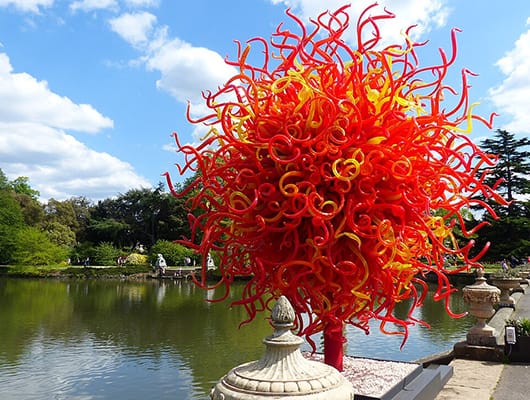
Summer Sun
In 2001, Chihuly began his Garden Cycle of large-scale site-specific glass artworks to be installed at historic botanical gardens around the United States and beyond. The first was installed at the Garfield Park Conservatory in Chicago, and the works were such a hit, that attendance to the garden tripled over the course of a year. Other Garden Cycle installations have been exhibited at ten other locations in the United States, as well as at the Royal Botanic Gardens, Kew, London, in 2005 and 2019 (where the fourteen-foot tall, 3500-lb piece Summer Sun was installed), and Gardens by the Bay, Singapore in 2021. In 2025, he will install more works at the Adelaide Botanic Garden in Australia.
Former Chairman of the Glass Department at California College of the Arts, Mark McDonnell, writes of the series, "It is not easy to work in a dialogue with nature. Plants grow, bloom, and otherwise follow their natural cycles over the course of an exhibition. Garden exhibitions can look like an afterthought when not successfully integrated with the plants. Planning these installations required lengthy discussions about plantings and their colors. For some venues, Chihuly's studio installed lighting for very popular night viewings. His glass installations were so responsive to light and the surroundings that many visitors felt as if no two visits to an exhibition produced the same experience."
Many critics see Chihuly's Garden Cycle as the pinnacle of his career, with art historian Samantha Baskind writing that "Set amid plants, flowers and abundant landscapes, the language of these seductive sculptures complements their natural surroundings in magical forms and patterns. Reciprocally, the greenery complements his creations."
The artist's wife Leslie Jackson Chihuly asserts that the series "has brought his singular vision to the landscapes and conservatories of botanical gardens across the United States. With this series of exhibitions and installations, he has been able to join two of his greatest loves - gardens and glass."
Blown glass - Royal Botanic Gardens, Kew, England
Mille Fiori
Chihuly has produced several Fiori (Italian for "flowers") artworks throughout his career, which are characterized by colorful, organic, free-flowing forms. One of these, Mille Fiori (2015), exemplifies the range of forms that comprise the Fiori works, with not only flower forms, but also spheres, spikes that recall agave, and groupings of elongated reeds that the artist has referred to as "Eelgrass," or "Marlins." This work can be seen as developing out of Chihuly's earlier Glass Forest installations (begun in 1971), in which groupings of elongated glass forms which appear to pool at the floor (looking something like toilet plungers) were filled with argon gas and neon, thus radiating a soft pink and blue light. And as in the Glass Forest work, in Mille Fiori the artist installed a shiny black platform on the floor to function like water, reflecting the landscape of forms above.
Curator Peter Fischer writes that these Fiori works "are not only manifestations of a self-sufficient artwork, but they also ennoble glass as an autonomous artistic medium. On a low, mirror-smooth free-standing black platform, a piece of mysterious glass vegetation unfolds into a magical garden in which time seems to stand still. The precise lighting of the environment supports the qualities that glass alone possesses, of having both body and transparency, and thus both reflecting the light and allowing it to pass through. Hundreds of individual glass objects are combined into an overall composition which - in musical terms - forms a polyphonic, harmonious body of sound. The reflective surface of the platform extends this fairy-tale world into the depths and gives it, supported by the lurching, tentacular forms, the appearance of an underwater garden."
Chihuly has produced many other Fiori works since the 1990s and even holds the record for the largest glass sculpture ever made, with another one of his Fiori works, the Fiori di Como (1998) on the ceiling of the lobby of the Bellagio hotel and casino in Las Vegas, commissioned by hotel owner Steve Wynn. The piece measures 2,100 square feet and is comprised of about forty tons of hand-blown glass in the form of over 2,000 brightly colored flowers of varying shapes and sizes, suspended by a steel rod armature (itself weighing about ten tons) hidden between the work and the ceiling. Despite its immense weight, it is frequently described as conveying a sense of lightness and ethereality, as if an enormous garden were in bloom overhead. Michele Quinn, owner of MCQ Fine Art, has asserted that with this piece, Chihuly became "instrumental in the perception of public art in Las Vegas," adding that it "was one of the most grand public art statements that has happened in Las Vegas. Ever. It really was impressive. It sort of has transcended time."
Hand-blown glass - Toyama Glass Art Museum, Toyama, Japan
Biography of Dale Chihuly
Childhood
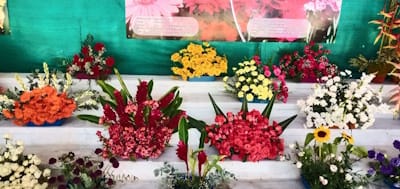
Dale Patrick Chihuly was the second of two children born to parents George and Viola Chihuly. His paternal grandfather had emigrated to the United States from Slovakia. His father was an organizer for the meat cutters' union in Tacoma, Washington. His mother was a homemaker who loved gardening, and he has pleasant memories of the family garden where the lawn was surrounded by azaleas and rhododendrons. When Dale was a child, she gave him the opportunity to decorate the family's basement, which he considers his "first foray into art and design." He also has fond recollections of family trips to the beach where he would scavenge for glass, and of family visits to flower shows at the Seymour Conservatory in Wright Park.
Tragedy struck the Chihuly family, however, when Dale's older brother George died in an accident while at Navy aviation training in Pensacola, Florida, in 1957. The following year, his father, George Sr., died of a heart attack at the age of just fifty-one. The emotional blow of these two losses struck Dale hard, and he began to run with a crowd of troublemakers, getting into petty vandalism such as breaking streetlamps (which he now looks back on as "my first work in glass!"). This vandalism eventually led to his arrest, after which point his mother more firmly pushed him to focus on his education.
Education and Early Training
Despite having no interest in pursuing further education after graduating from Woodrow Wilson High School in 1959, Chihuly enrolled at the College of Puget Sound, transferring one year later to the interior design program at the University of Washington in Seattle, where he joined the Delta Kappa Epsilon fraternity. It was at the University of Washington that he first learned to work with glass. The artist's wife, philanthropist, and arts promoter Leslie Jackson Chihuly explains that "The skills he gained during that time have stayed with him: Dale's treatment of space and understanding of how his work will interact with its surroundings, whether a building, a loft, a garden, or a museum, owe much to his early training." In 1962, however, he dropped out of university to study art in Florence, Italy. He then travelled to the Middle East, where he befriended American architect Robert Landsman, who encouraged him to resume his studies.
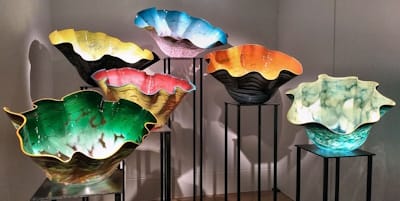
In 1963, Chihuly took a weaving class with University of Washington faculty member Doris Brockway, in which he decided to incorporate glass shards into his tapestries, and the following year this work earned him an award from the Seattle Weavers Guild. Finally, in 1965, he graduated with a Bachelor of Arts degree in interior design from the University of Washington. By this point, his energies were entirely focused on glassblowing, and in 1966 he received a scholarship to study at the University of Wisconsin-Madison, studying under Harvey Littleton, known as the "father of the Studio Glass Movement," who established the first glass program in the United States at the institution. Chihuly earned his Master of Science degree in sculpture in 1967.
Having made a complete 180° turn, and now entirely comfortable with formal education, Chihuly enrolled in the Rhode Island School of Design (RISD), where he earned a Master of Fine Arts degree in sculpture and ceramics in 1968, and where he befriended Italian American artist Italo Scanga.
Mark McDonnell, former Chairman of the Glass Department at the California College of the Arts, explains that Chihuly was at RISD during "a transformative period in the art world when everything was being questioned and challenged. Minimalism was de rigueur, but performance , happenings, conceptual art, Land art, and earthworks had also emerged as viable art movements. Many renegade artists opposed the commodification of art. They rejected the idea that museums and galleries were the only places to display and experience art. Artists were working in nature with materials often found on-site, and at times photographs were the only documentation of their work. The notion of impermanence in art, and the role of photography in documentation, resonated deeply with Chihuly."
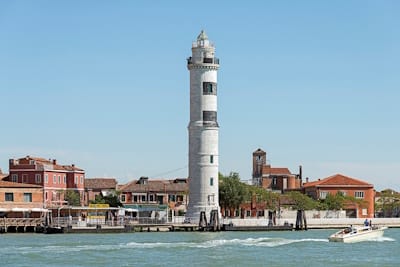
Shortly after graduating, Chihuly would establish RISD's own glass program, where he taught until 1980. Around the same time, he won a Louis Comfort Tiffany Foundation grant for his work in glass, as well as a Fulbright Fellowship, which he used to travel to Venice to apprentice at the Venini glass factory on the island of Murano. As arts writer Jennifer H. Opie notes, "On acquiring the fellowship, Chihuly wrote to several hundred glassworks on Murano. Only one responded positively. Ludovico Diaz de Santillana, director of the Venini glass company and son-in-law of the founder, Paolo Venini, invited Chihuly to spend three weeks in the factory. For the first American glassblower to receive such an invitation, it was a remarkable opportunity. It was even more remarkable considering that for centuries a tradition of secrecy and protectionism characterized the Venetian glass industry. Chihuly was fortunate: Venini was one of the most progressive and open-minded of the Muranese glassworks, partly due to its relatively short and exceptional history. It was established in the 1920s not by a local glassmaking family but by a Milanese lawyer, Venini."
At Venini, Chihuly learned about the importance of teamwork in the glass-blowing process. Opie writes, "In this highly intensive craft industry, everyone plays a vital part in a closely structured workforce at each individual furnace, and Chihuly learned this process very well. Beyond this entirely practical tradition, the glitter of Venetian glass and the heat, noise, and sheer bravura of the Muranese hot shops were undoubtedly seductive, chiming with Chihuly's own youthful hunger for ideas and his ambition to master so demanding a material. Nevertheless, by his own admission, he took some time to settle there." Chihuly has explained, "I was too intimidated to blow glass myself, because I was such a lousy glassblower compared to the greatest that were there." He used his off-hours in Venice to visit other glass workshops and learn more about beadwork, lampworking, and mirror making.
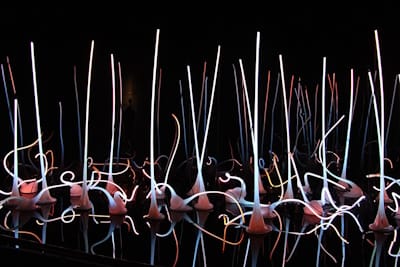
Back in the United States, Chihuly spent the next four summers teaching at the Haystack Mountain School of Crafts in Deer Isle, Maine, while spending the rest of the year traveling - such as a trip to Europe in 1969, where he met glass artist, painter, and printmaker Erwin Eisch in Germany, and painters and glass artists Stanislav Libenský and Jaroslava Brychtová in Czechoslovakia. In 1971, Chihuly cofounded the Pilchuck Glass School in Washington State, seeking to lead "the avant-garde in the development of glass as a fine art." While at Pilchuck, he made his first environmental installations - a grouping of clear glass bulbs floating on Pilchuck Pond.
Mature Period
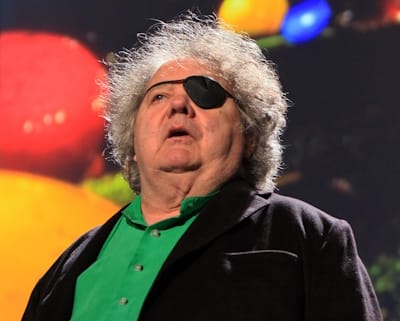
In 1976, while in England, Chihuly was involved in a head-on vehicle collision that sent him flying through the windshield. In what could be seen as a sort of poetic irony, he sustained severe cuts from the glass (requiring over 250 stitches to his face), and was left permanently blind in his left eye, which meant that his depth perception was impaired. Nevertheless, he pushed on and continued to blow glass on his own until 1979, when a bodysurfing accident dislocated his right shoulder. This second major injury forced him to reevaluate his working method, and to finally admit he required a team to assist him in his glassblowing work. As his head gaffer (glassblower) explained: "We're like an orchestra, Dale doesn't play an instrument, but he's the guy up front with the baton." Chihuly was reticent at first to delegate so much of his process to others, but eventually admitted "Once I stepped back, I liked the view."
The 1980s would kick off Chihuly's rise to international fame due to his establishment of a signature artistic style, recognizable upon sight. This included his chandelier works, comprised of hundreds of whimsically blown forms. In 1986, he received a solo exhibition, "Dale Chihuly: Objects de Verre," at the Musée des Arts Décoratifs, Palais du Louvre in Paris. In 1999, his "Chihuly in the Light of Jerusalem" installation at the Tower of David drew over a million visitors. And in the early 2000s, he began his Garden Cycle exhibitions, showcasing his work in botanical gardens and conservatories.
The artist and his team have continued to produce groundbreaking glass art, and Chihuly has become a household name. Alongside this immense fame has come criticism that the artist has "sold out" or become overly "commercialized," creating work that is merely "decorative," or "kitsch." Yet many recognize his importance, like art historian Samantha Baskind writing that Chihuly "revolutionized the art of glass blowing, elevating perceptions of the medium from craft to fine art."
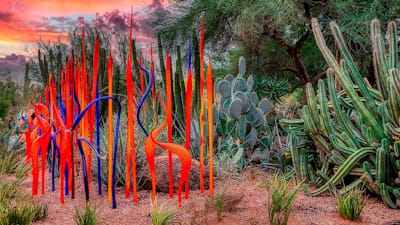
On May 21, 2012, a permanent exhibition space called Chihuly Garden and Glass opened in the center of Seattle. In 2013, Chihuly was awarded an honorary doctorate from the University of Washington. Today, he continues to produce individual glass pieces as well as immersive glass environments, both inside gallery and museum spaces, as well as site-specific outdoor works.
The Legacy of Dale Chihuly
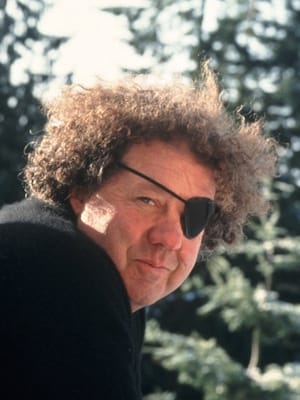
Dale Chihuly has been at the forefront of the Studio Glass Movement since its inauguration in the 1960s, when two historic glassblowing workshops were led by Harvey Littleton and Dominick Labino at the Toledo Museum of Art in 1962. This marked a shift from the functional glass forms mass-produced in factories to the unique or limited-edition glass sculptures made by artists in independent studios, and as art historians like James W. Yood and Samantha Baskind insist, Chihuly played a central role in developing glass art as a form of fine art (rather than mere craft) internationally. Says Baskind, "The unrivaled glassmaker has forever shattered all expectations of his medium." Artist Fritz Dreisbach has asserted that "Everyone is influenced by Chihuly, in one way or another."
Curator Peter Fischer writes "That Chihuly has an established place in glass history is undeniable. [...] One thing is certain: Chihuly's contribution to the serious business of making art is unique. However, defining his particular significance is no easy matter, and many critics are unsure whether to suspect his evidently popular appeal or to submit to that same irresistible seduction."
Fischer adds: "His major installation projects centered on landscape or water, in historical or contemporary architectural settings, are often rampantly theatrical. The luxuriant colors and the raw energy that are Chihuly's trademarks are often compared to the paintings of Henri Matisse and Jackson Pollock. The swirling, organic forms call up comparisons with sea creatures and unruly plants. Even 'The Garden of Delights... the upside-down world, or nature unhinged,' of the fifteenth-century painter Hieronymus Bosch has been invoked. There are as many interpretations as there are audiences." Art historian Barbara Rose even asserts that "Chihuly is the only artist, outside of Robert Rauschenberg perhaps, who manages actually to live out the sixties dream of making environmental art for the people and of connecting groups in communal situations."
Chihuly's influence can be seen in the younger generation of glass artists he has trained at his workshop and at his Pilchuck Glass School State, including Joey Kirkpatrick and Flora Mace.
Influences and Connections

- Italo Scanga
- Erwin Eisch
- Stanislav Libenský
- Jaroslava Brychtová
- Lino Tagliapietra
-
![Art Deco]() Art Deco
Art Deco -
![Institutional Critique]() Institutional Critique
Institutional Critique -
![Minimalism]() Minimalism
Minimalism -
![Post-Minimalism]() Post-Minimalism
Post-Minimalism - Studio Glass Movement
- Joey Kirkpatrick
- Flora Mace
- Italo Scanga
- Erwin Eisch
- Stanislav Libenský
- Jaroslava Brychtová
- Lino Tagliapietra
- Studio Glass Movement
Useful Resources on Dale Chihuly
- The Boathouse: The Artist's Studio of Dale ChihulyOur PickBy Leslie Jackson Chihuly, David B. Williams, and William Warmus
- Chihuly: An Artist CollectsBy Bruce Helander
- World of Glass: The Art of Dale ChihulyBy Jan Greenberg and Sandra Jordan
- A Flash of Color and Light: A Biography of Dale ChihulyBy Sharon Mentyka and Shelley Couvillion
- Team ChihulyOur Pick
- Chihuly Silvered
- Chihuly Jerusalem 2000
- Chihuly Black
- Chihuly Cylinders
- Chihuly Venetians
- Chihuly Ikebana
- Chihuly Baskets
- Chihuly Persians
- Chihuly and ArchitectureBy Eleanor Heartney
- Chihuly: 1968-1996By Donald B. Kuspit
- Chihuly Garden InstallationsBy David Ebony and Tim Richardson
- Chihuly Gardens & GlassBy Barbara Rose, Lisa C. Roberts, and Mark McDonnell
- Chihuly: On FireOur PickBy Mark McDonnell
- Chihuly: Through the Looking GlassOur PickBy Gerald W. R. Ward
- Dale Chihuly: A CelebrationBy Rock Hushka
- ChihulyOur PickBy Joanna L. Groarke
- Chihuly: On Color and FormOur PickBy Davira S. Taragin
- ChihulyOur PickBy Diane Charbonneau
- Chihuly DrawingsBy Barry Rosen
 Ask The Art Story AI
Ask The Art Story AI











